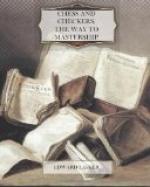The same two leading principles apply to Queen’s Pawn openings which were discussed in connection with the King’s Pawn openings; but there is one great difference between the two kinds of openings which is not obvious to the beginner. This is the fact that in Queen’s Pawn openings, in most cases, neither player has a chance to open a file in the center of the board through the exchange of one of the center-Pawns, and that, therefore, an additional Pawn move is necessary in the opening stage to provide for an open file in which the Rooks later on may have an opportunity of entering the battle.
In addition, it is in most variations not easy to find a good place for the Queen’s Bishop without further Pawn moves, and it is here where the beginner is bound to err in the plan of his mobilization unless he has adequate instruction.
In trying to open a file for the Rooks it will be advisable—just as in the King’s Pawn openings—to aim at the same time at the clearing away of the opponent’s center-Pawn, and this can only be done by the advance of the c-Pawn. Therefore, it would mean loss of time if the Queen’s Knight were developed into the c-file before the c-Pawn has moved; the Knight would have to be moved away again in order to enable the opening of the c-file. This consideration furnishes the key for the understanding of the most popular Queen’s Pawn opening, which is
(1)
P-d4 P-d5
(2)
Kt-f3 Kt-f6
(3)
P-c4
White offers a Pawn to induce Black to give up his center-Pawn, hence the name “Queen’s Gambit.” If Black could actually hold the Pawn he would be justified in accepting the Gambit unless it can be demonstrated that White’s advantage in development yields a winning attack. However, White can easily regain the Gambit-Pawn, and so there is absolutely no reason why Black should give up his Pawn-center.
The way in which White regains his Pawn in the accepted Gambit is this: (3) ..., Pxc4; (4) P-e3, P-b5; (5) P-a4, P-c6 (if Black takes the Pawn a4, White captures the Pawn c4 and then regains the a-Pawn. (5) ..., P-a6, cannot be played on account of Pxb5, opening the a-file for White’s Rook so that Black cannot retake the Pawn). (6) P-b3, Pxb3; (7) Pxb5, Pxb5; (8) Bxb5+ and Qxb3.
Now White is far ahead in the development and in addition he has an open file for his Queen’s Rook in which the black Pawn is bound to be lost in the long run. Moreover, Black has no compensation for White’s strong Pawn-center.
For this reason the Queen’s Gambit is hardly ever accepted and the following defense played instead:
(1) P-d4 P-d5 (2) Kt-f3 Kt-f6 (3) P-c4 P-e6 (4) Kt-c3
Black has now the choice between either advancing his c-Pawn right away or first developing the pieces of his Queen’s wing. In the latter case he cannot place the Queen’s Knight on c6 as this would block the way of the c-Pawn. He must develop him to d7. This appears to be a bad move as it blocks the way of the Queen’s Bishop, but this Bishop will have to be developed in a different diagonal anyway as the Pawn e6 cannot advance opening the diagonal c8-h3.




